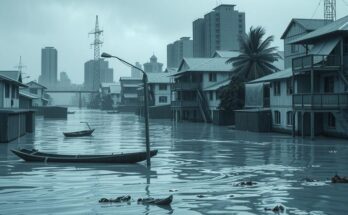Cyclone Dikeledi is moving away from Mayotte while causing fatalities and floods in Madagascar. At least three people died due to the storm’s impact, which has affected over 900 residents in northern Madagascar. Mayotte remains on red alert with strong winds and rain impacting daily life. Preparations are in place for potential cyclonic intensification as recovery efforts continue.
On Sunday, Cyclone Dikeledi was observed moving away from Mayotte, a French territory which remains under a red alert until Monday evening. In Madagascar, the cyclone caused severe flash floods, resulting in the deaths of at least three individuals and affecting over 900 others. The storm made landfall on Madagascar’s northern coast on Saturday night before weakening into a tropical storm, with the most significant impact reported in the Antsiranana province. In Mayotte, residents braced for the storm as it passed closely by, with winds reaching speeds of 80-90 km/h in parts of the island. Preparations included mobilizing more than 4,000 officials for emergency response, as many locals expressed concerns regarding potential destruction reminiscent of the recent Cyclone Chido that had caused considerable damage in December.
Despite being confined indoors due to the red alert, some residents were spotted attempting to repair roofs damaged by the heavy rainfall. As Dikeledi is forecasted to potentially reclassify back to a cyclone on Monday, authorities in affected regions are taking necessary precautions to mitigate further implications of the storm. Blanket accommodations for nearly 14,500 people have been established amid ongoing recovery efforts from previous cyclonic impacts.
Cyclone Dikeledi has emerged in the Indian Ocean, following a recent devastating cyclone in December that impacted Mayotte significantly. Mayotte, one of the poorest departments of France, is particularly susceptible to natural disasters due to its geographical location. With an estimated population of 320,000, including thousands of undocumented residents living in makeshift housing, the region faces challenges in disaster resilience. As such, authorities have been mobilizing resources and personnel in anticipation of cyclonic activity, which can lead to severe flooding and infrastructure damage in these densely populated areas.
In summary, Cyclone Dikeledi has posed serious threats to both Mayotte and Madagascar, resulting in loss of life and significant disruption. The cyclone’s trajectory has raised alarms, with red alerts and emergency personnel mobilized to manage the evolving situation. As further measures are implemented to safeguard residents, the need for long-term recovery solutions remains critical, particularly following the extreme weather events experienced in the region over the past months.
Original Source: www.rfi.fr




